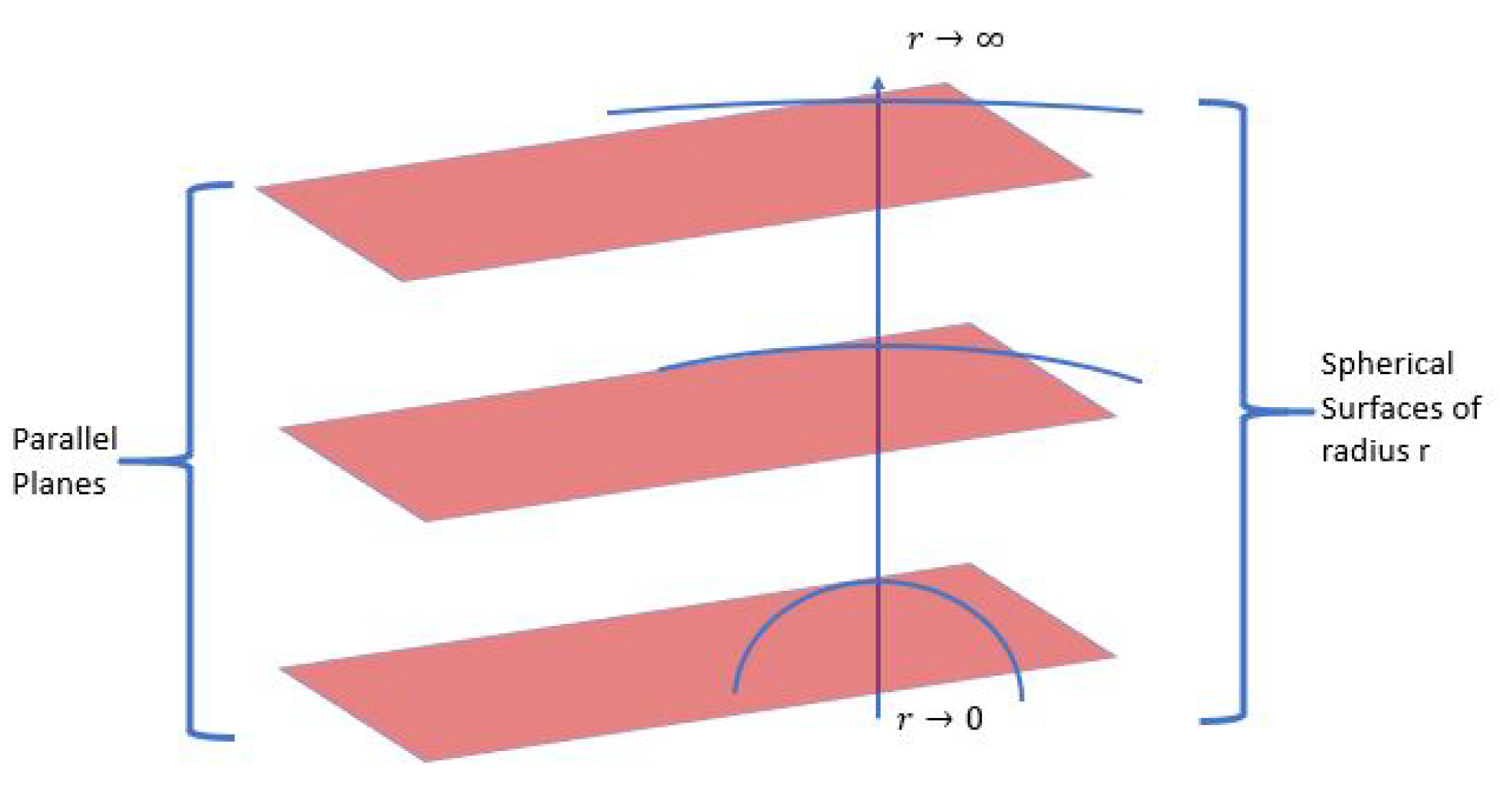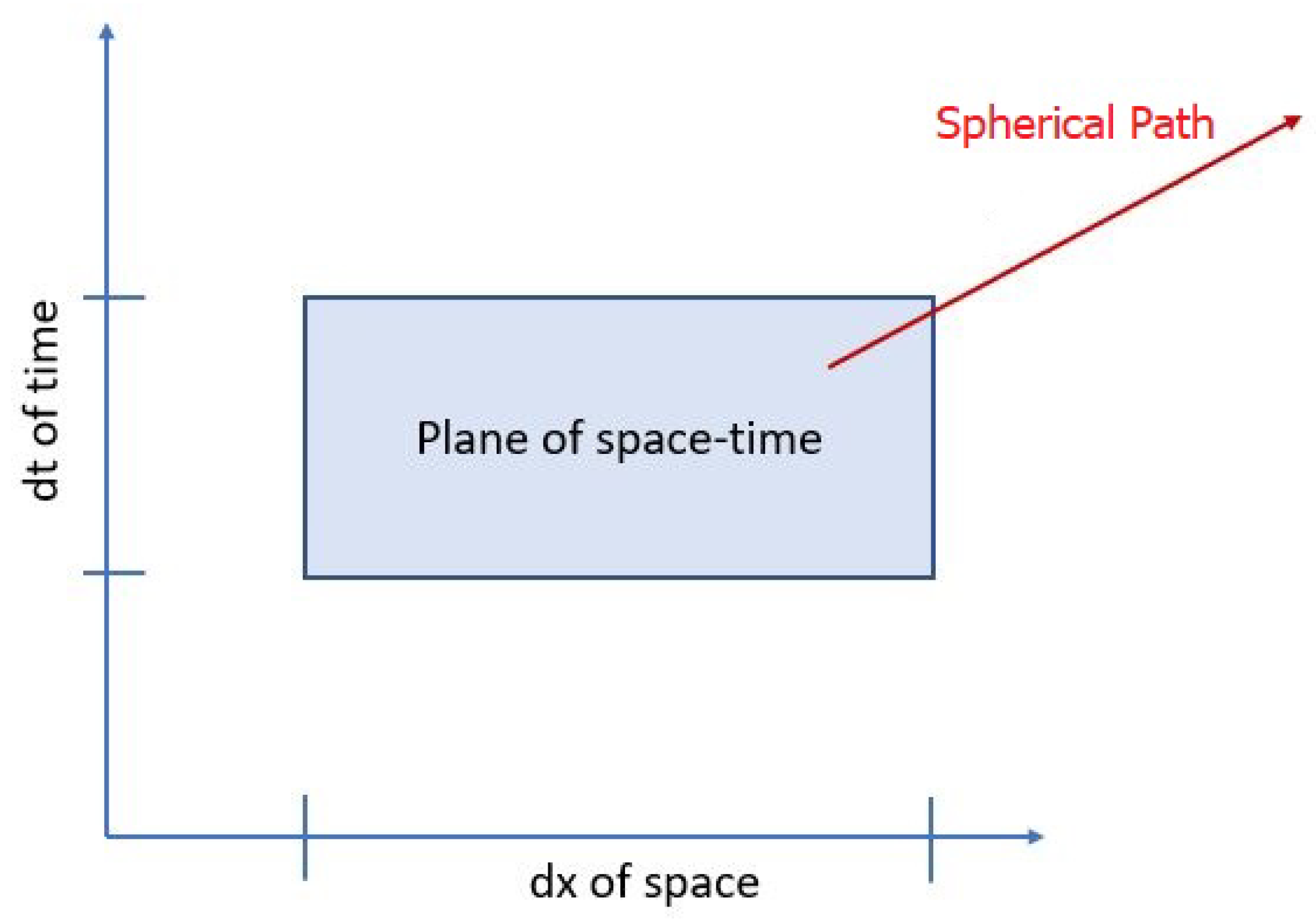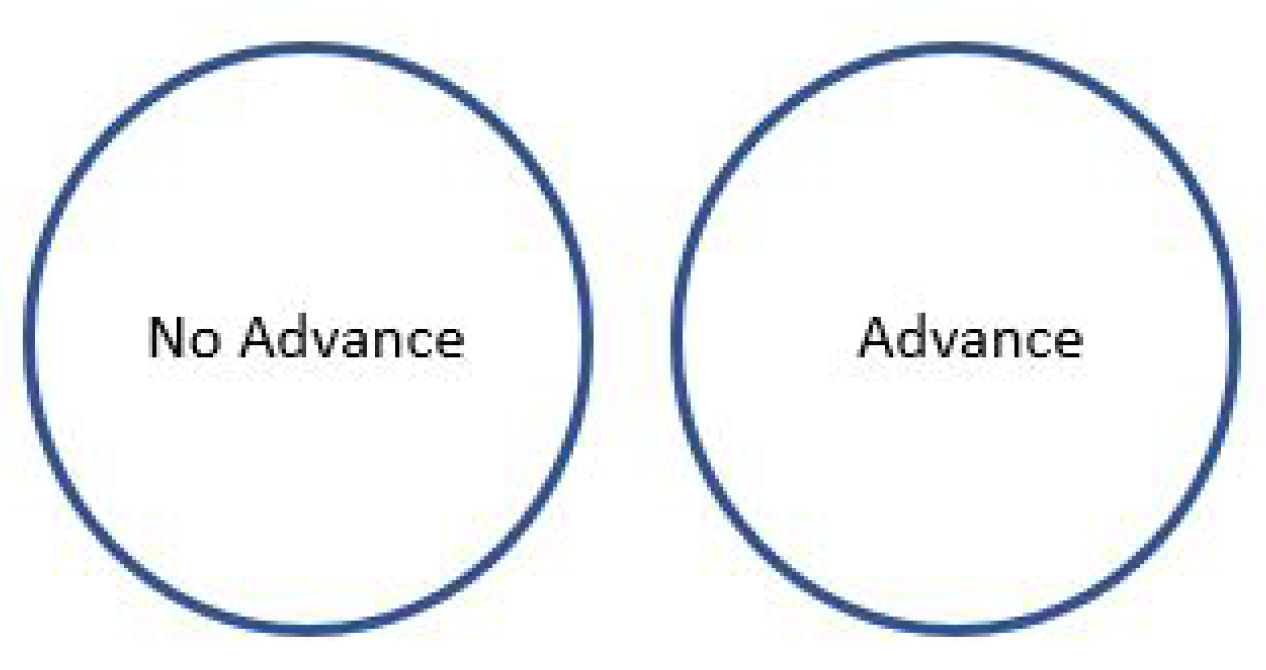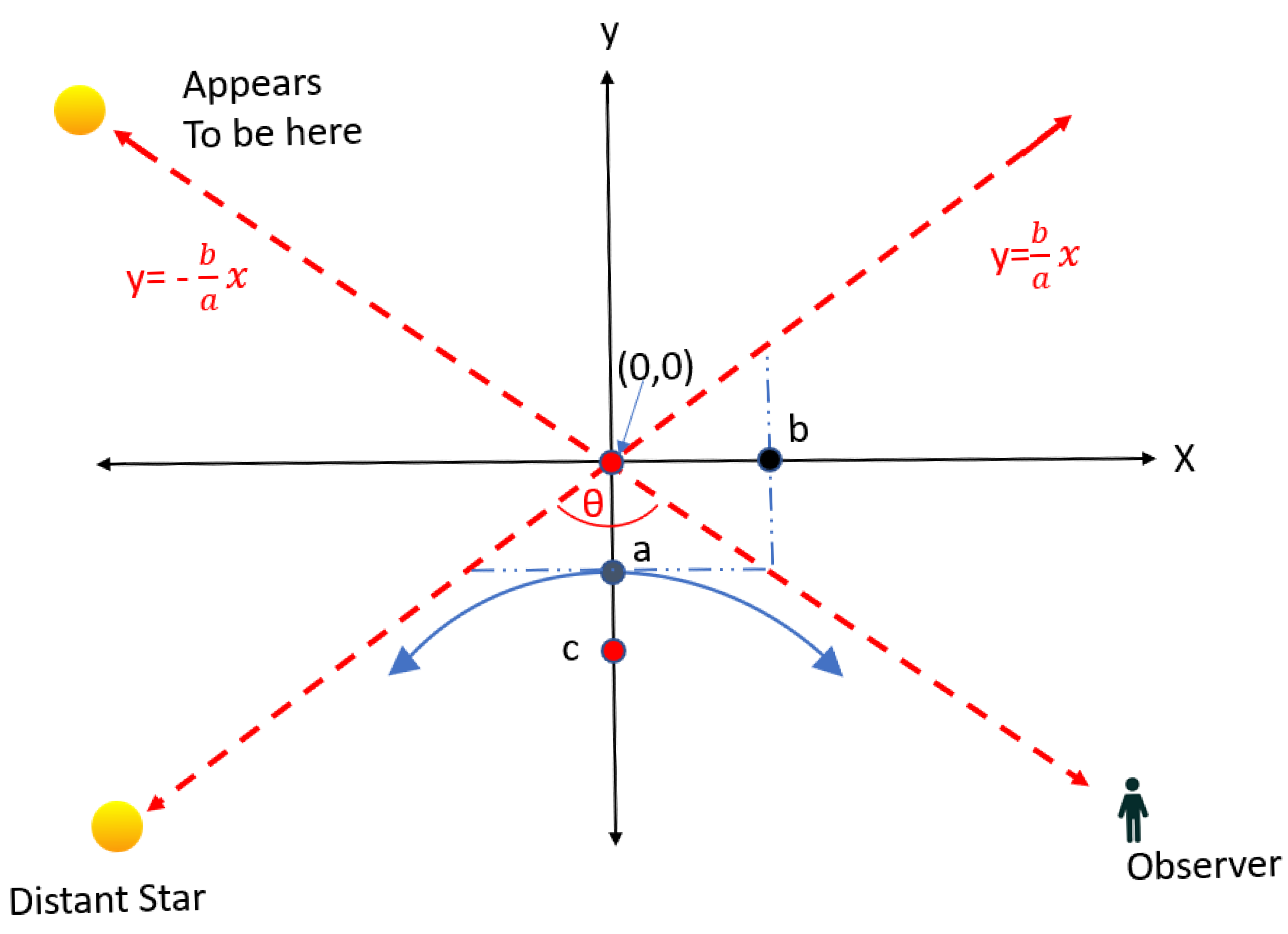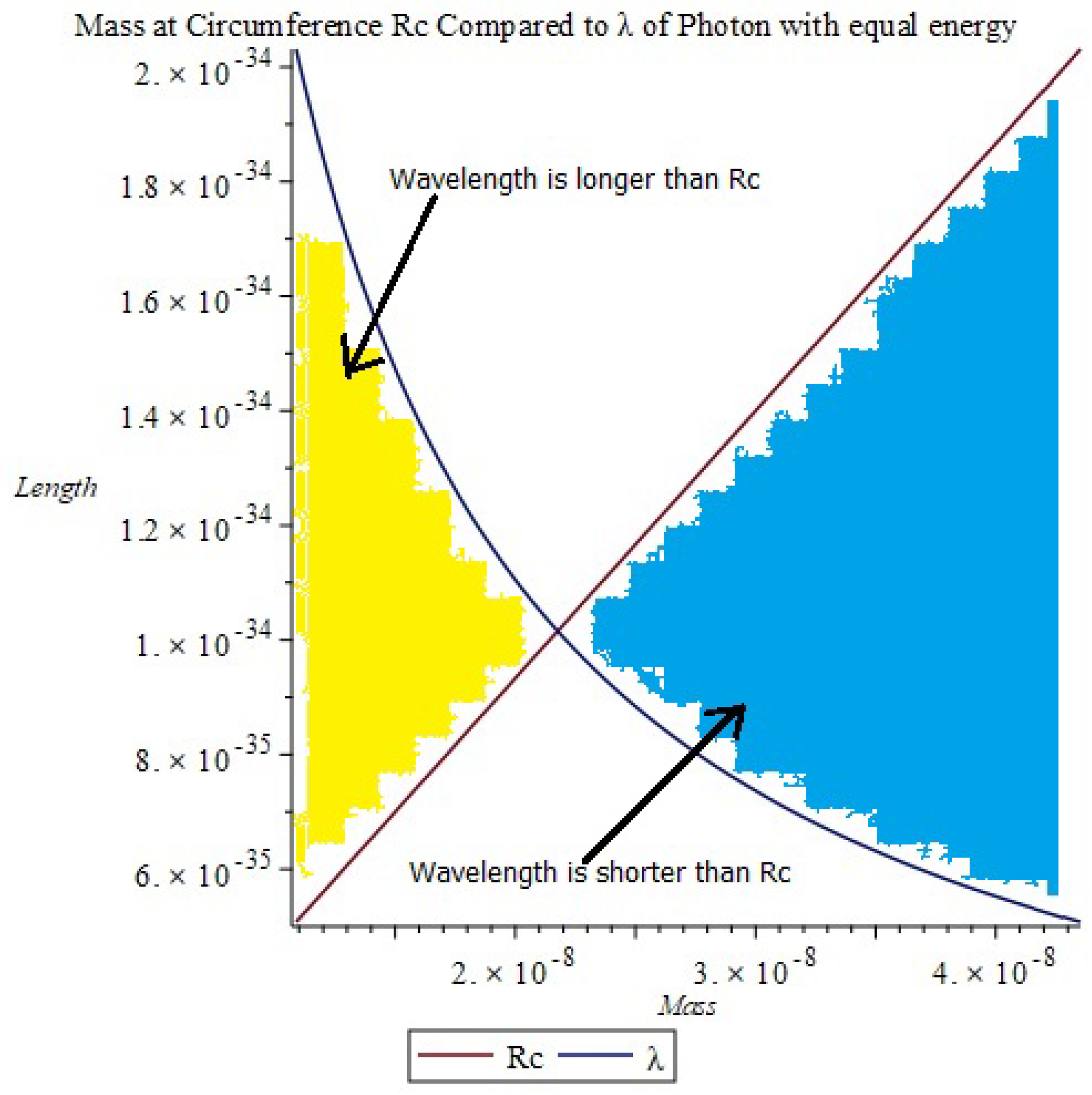4.1. Initial Manifold
The math of General Relativity is based on differential geometry, specifically that of a Riemannian Manifold [
4]. Therefore it would be idea to start with this mathematical structure as an initial formalization. Einstein, in the beauty of his theory give a very simple looking equation (though in the opinion of many, including the author, not simple in evaluation):
The simplicity of the concept is elegant. Stress energy warps space and the warping of space decides how a free particle moves. Arguably the most popular solution to Einstein’s field equations is the Schwartzschild metric [
7]. With this solution one may solve for many of the predictions of GR, including perihelion advance of Mercury (and other gravitational orbits), time dilation, light bending around massive objects, and so forth. Since the Schwartzschild metric is based on a static configuration (field does not change over time) it does not directly support the calculations of gravitational waves, as they require the field to change over time as the wave propagates. But none-the-less the Schwartzschild solution is elegant in the same manner Einstein’s theory is.
Although the transformation from equation
5 was shown to be equivalent to a first order series of Schwartzschild’s metric for time dilation, it does not translate to a solution for Einstein’s field equations when one sets the stress energy tensor equal to zero (empty vacuum). Though this is not a solution to Einstein’s equations it doesn’t exclude equation
5 from using the math structure of a manifold or possibly a Riemannian manifold.
The model at this stage of development considers two events that dilate time in a field; the presence of a mass (globally affects the field), and the acceleration of mass (locally affects the field). Mass and energy at this stage are not considered interchangeable on a global level, only between inertial frames as in SR. Each of these will need to be treated separately and independent of each other. Looking at equation
24, local and global effects are decoupled as:
The local part is contributed by the kinetic energy due to acceleration of the particle moving in the field and therefore has a relative value to the frame it is observed from. To standardize the observation, all measurements for the local part will be made locally with instantaneous velocity measured with respect to a stationary (in SR terms at rest) observer in space. In a configuration like the Schwartzschild metric the central mass is at rest with an observer in space (at infinite distance from the central mass), but caution should be used to not treat this as a default unless specified. In cases where an orbiting body’s mass is not much much less than the center mass a measurable effect may be loss by holding the the assumption the central mass is at rest in relation to an observer at rest in .
Armed with how to take measurements, the next step is to setup a manifold. The manifold
is smooth with dimensions
with three spatial components and one temporal. The metric tensor is:
Where
I is the identity matrix and
is from equation
24. In a Euclidean coordinate system the metric reduces to a scalar ratio connection between local coordinate systems. Thus a distance all observers agree to is:
Where the infinitesimal
are measured locally. The time unit scales in the same manner as length.
Where unit time is measure locally.
One observation from this configuration is one can form parallel tangent planes along the radial. On a spherical surface with radius equal to the parallel planes tangent to the surface, all tangent spaces on the spherical surface will share the same scalar value for the metric. This is visualized in
Figure 1.
Further observation is as the spherical surface asymptotically approaches the tangent surface. At an infinite distance away from the massive object generating the field, the tangent surface and the radial surface are the same. These tangent planes and radial surface correspond to and have a value of 1, allowing the entire space to be treated as Euclidean. As the rate at which the radial surface separates from the tangent plane (the curvature) increases. For now, dealing with the point at is delayed to later in the formalization for reasons that will become apparent.
A foliation of manifolds formed by concentric spheres where
can be formed. Each manifold well have the same scalar valued metric for the whole surface. Transforming coordinate values from one leaf of the foliation to another amounts to a scalar multiple of the coordinates. In this transformation consider the following calculation. Pick any
r value greater than zero and not in
and draw out a great circle path on the surface of sphere with radius
r. Align a plane such that it contains the great circle path. On the plane it will form a circle of radius
as measured locally. Project this circle onto a parallel plane in
and it will form a circle with a radius less than
. This can be shown with the transformation from equation
24 by transferring the length of radius
to
. The reverse process can be performed by using the inverse of
, in which case the image of the circle in
will be projected onto a leaf in
space.
Next consider a test particle moving along this path and how its trajectory is transferred to the plane in
. This requires the local effect of equation
26 to be considered in addition to the global effect since the trajectory must have a velocity about the path to traverse the path. Here the dimensions of 3+1 comes into play. Unlike GR this is 3 dimensions with time separate, thus the distance does not include time within its calculation. None-the-less time is being swept out as the test particle transverse the path and as such its transformation scalar from
should be considered. To visualize see
Figure 2, as space is transverses so is time, therefore the value of
should be squared when moving through both time and space (unlike a static transformation where time is not considered).
Thus, a particle undergoing acceleration will traverse an arc length greater than the arc length predicted by the calculation using only the global effects of the field. Both predict a greater arc length than if there is no field effect (global or local). The local effect is predicted for both a gravitation field generated by a mass and in an empty vacuum. Consider only the gravitational field (global):
And when only the local effect due to acceleration is considered:
In both cases the value of is greater than 1, thus the arc length traversed is greater than . Note: This is for a circular path projected from to .
Experiments performed in one lab will transfer to another lab by:
Consider an orbit in
, since there is no gravitational effect the objects orbital velocity will be measured by
, but without the global field effect, only the local accelerated effect takes place. The local effect is:
Locally at a leaf foliation of
r radius, the arc length is:
Note, this is NOT saying two observers see two different arc lengths of the same event. Instead it is predicting the same experiment (an orbiting particle) performed in two labs, one in
and the other in
at radius
r from the generating mass, will transform accordingly. Equation
33 for the lab in
and equation
34 for the lab in
. All experiments in
with the same
r under the influence of a single non-rotating massive object will transform the same (1 to 1).
For an observation of the same event, the measurements transfer using equations
28 and
29.
At this juncture in the development the setup looks very much like GR, and it should as GR is a well backed theory by empirical data when dealing with the very large. There are several major differences, this model has not placed a strong constraint on the curvature of space being determined by the stress energy tensor or even energy, this model has not introduced geodesic’s as a free particle’s motion. Some corresponding calculations have been derived, but that is the extent of similarity at this juncture.
The model’s manifold that is built on the metric in equation
27 has an inherent issue. Consider the static transformation of distance
d in a gravitational field from
to
When
the transformation is
When distance
, distance
. This causes a shift in what is observed at infinity to what is physically happening. Zero is observed when there is still a magnitude or
r greater than zero. This makes a type of discreteness/discontinuity at zero, a type of shift as shown in
Figure 3. When working with discrete spaces calculus is not an option, nor are Riemannian manifolds. Thus, the ability to transfer between spherical surfaces needs a solution that is not continuous. A method to approximate with the ability to scale to a high level of precision is sought. For clarity and completeness, the transformation does not create a pure numerical discreteness. Instead it creates a shifted zero quantity (
), thus every number on a number line is shifted by observation, but the underlying forces must be calculated using the un-shifted values. Consider a transformation of a radial distance:
Where
k is a constant. When
,
is not zero. Thus any
between spherical radial lengths is:
To an observer the
k value is not measured since they started at zero with no gaps (it was considered smooth when they measured the difference), but the physical laws behave with the
k value included. Contemplate a center potential energy calculated as
as measured by an observer, but hidden to the observer is the shift in zero as in
Figure 3, thus what is measured is
When a
is calculated it is not
but
When the difference is not measurable, but as r approaches k in magnitude the measurements will show a considerable difference. Secondly, if there is a summation over spherical surfaces of differing r magnitudes the k value may become a multiplied effect. In the models transformation a radial orbit could be observed as zero magnitude, yet the observed center based force would not be zero.
The model at this juncture predicts when observing the large () there is a negligible (possibly not even measurable) effect when considering a smooth manifold. But as there may be conflicting observations to physical laws like a based force, where a zero radius produces a force. When gravitational forces are involved, the values below show a residual radial magnitude when radius is zero in .
Static (No Particle Acceleration)
The static only has the global field effect, free fall and orbital have both global and local effects.
*The free fall affect will be closer analyzed later as its motion (acceleration) is in the same direction as the field. It should be noted in Schwartzschild’s solution to Einstein’s equation the metric
is used when transforming the length
as observed from infinity [
7] to a local position within the gravity well the metric reduces to:
By performing a series expansion about
and observing when
a constant in the series emerges.
This is the same as the model’s static zero value from equation
45. It appears GR has the same number line shift built into it. As
the
r in
cancels leaving the constant value from equation
49. It should be noted the value
has been termed the characteristic value for a gravitational system [
4].
It is here the author contends the model’s transformation corresponds to GR when
and only the static field is considered (no motion in the field) as shown in equation
7. At values of
r where
the model’s number line shift has less and less impact allowing the treatment of a smooth manifold in these areas to produce small effects (possibly immeasurable errors compared to empirical data). But unlike GR, this model does reflect the constant from the series and exploits to form a possible seamless path to a unified theory.
Observing
Figure 3 it is not a large jump to understand how a type of gravitational wave might propagate throughout space as the mass or the center of mass changes over time.
Having shown a manifold approach does not work for the model, one possible starting place is to consider transformation from one frame (coordinate system) to another. This is not straightforward as there are a minimal two types of transformations; static and dynamic.
